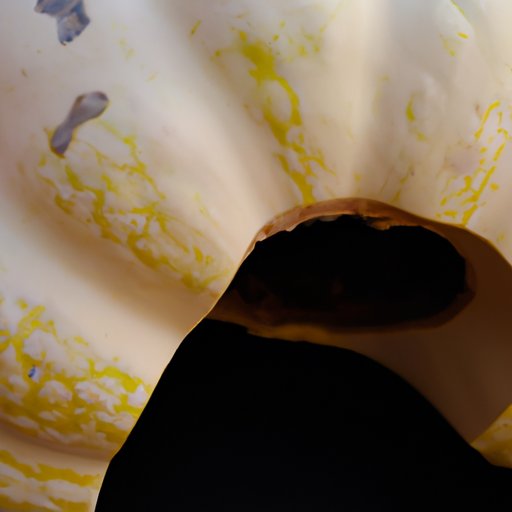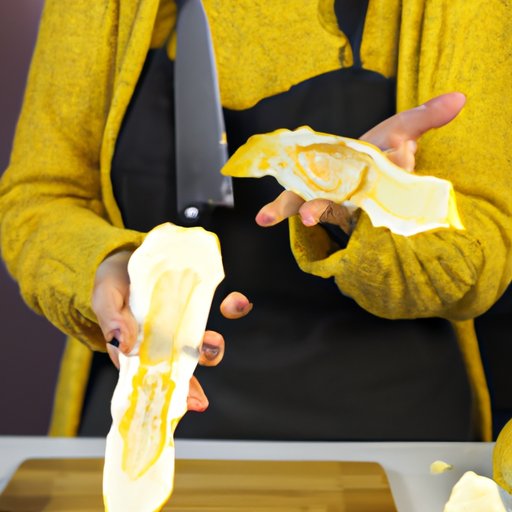
Introduction
Butternut squash is a beloved fall vegetable that often finds its way into soups, stews, and casseroles. While most people know that the flesh of the squash is edible, there is a lot of confusion when it comes to the skin. Can you eat butternut squash skin? The answer might surprise you.
The purpose of this article is to examine the pros and cons of eating butternut squash skin, and to explore its nutritional benefits. We will also address common myths and misconceptions about eating it and provide instructions for preparing it safely as a healthy snack.
The Surprising Truth About Eating Butternut Squash Skin
In short, the answer is yes, you can eat butternut squash skin. And, in fact, it’s not uncommon to do so in some parts of the world. For example, in parts of Africa, the Middle East, and Central America, butternut squash is often prepared with the skin on. Some chefs even consider it a delicacy.
The Pros and Cons of Eating Butternut Squash Skin
There are advantages and disadvantages to eating butternut squash skin to consider.
Advantages of Eating Butternut Squash Skin
One of the main benefits of eating butternut squash skin is that it’s high in fiber. In fact, the skin contains more fiber than the flesh. Fiber is essential for digestive health and can help prevent constipation. Additionally, the skin contains various vitamins and minerals, including vitamin C, potassium, and magnesium. By eating the skin, you’re getting more of these nutrients.
Eating the skin can also help reduce waste. When you peel butternut squash, you’re throwing away a substantial portion of the vegetable. By eating the skin, you’re making the most of your food and reducing your ecological footprint.
Disadvantages of Eating Butternut Squash Skin
One potential disadvantage of eating butternut squash skin is its texture. The skin can be tough and chewy, which may not be enjoyable for everyone. Additionally, pesticides can accumulate on the skin, so it’s essential to wash it thoroughly before eating.
Why You Should Try Eating Butternut Squash Skin
If you’re looking to add more fiber and nutrients to your diet, eating butternut squash skin is an easy way to do so. It’s also a sustainable practice that helps eliminate food waste. If you’re hesitant to try it, there are ways to make the skin more palatable. For example, roasting the squash can soften the skin and make it easier to eat. Blending it into a soup or puree can also help disguise the texture.
The Nutritional Benefits of Eating Butternut Squash Skin
The skin of butternut squash is rich in several nutrients that are beneficial to your health. For example, vitamin C is an antioxidant that can help boost your immune system. Potassium is essential for maintaining healthy blood pressure, and magnesium is essential for bone health and nerve function. Additionally, as mentioned earlier, the skin is high in fiber, which can improve digestive health and reduce the risk of chronic diseases such as heart disease and diabetes.
Myths and Misconceptions About Eating Butternut Squash Skin
There are some common misconceptions regarding the safety and digestibility of butternut squash skin.
Firstly, some people worry that the skin may be toxic due to pesticide use. While this is a valid concern, washing the skin thoroughly can help remove any pesticide residue. It’s also worth noting that butternut squash is not a crop that’s heavily treated with pesticides compared to other vegetables.
Another concern is that the skin may be hard to digest, leading to digestive discomfort. However, the skin is perfectly digestible for most people. As with any food, some individuals may be more sensitive than others, so it’s best to listen to your body and stop eating the skin if you experience discomfort.

How to Safely Prepare and Enjoy Butternut Squash Skin as a Healthy Snack
If you’re interested in trying butternut squash skin, here’s how to prepare it safely:
- Wash the squash thoroughly under running water to remove any dirt or debris.
- Cut off any stems and slice the squash in half lengthwise.
- Use a spoon to scoop out the seeds and pulp from the center.
- Using a sharp knife, carefully remove the skin from the squash. Alternatively, you can leave the skin on and roast the squash.
- If you’ve removed the skin, cut it into small pieces and season with salt, pepper, and any other spices you like (e.g., paprika, cumin).
- Place the skin pieces on a baking sheet and roast in the oven at 375°F for 12-15 minutes, or until the skin is slightly crispy.
- Serve the roasted skin as a snack with your favorite dipping sauce, or add it as a flavorful topping to soups or salads.
Conclusion
After exploring the pros and cons of eating butternut squash skin, it’s clear that there are many benefits to doing so. In addition to being high in fiber and nutrients, it’s also a sustainable practice that can help reduce food waste. While the texture of the skin may not be to everyone’s liking, there are ways to make it more palatable. So, the next time you’re preparing butternut squash, consider keeping the skin on and giving it a try.




